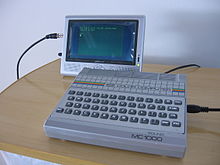CCE MC-1000
 | |
| Manufacturer | CCE (Indústria e Comércio de Componentes Eletrônicos S/A) |
|---|---|
| Type | Home computer |
| Release date | 1985 |
| Introductory price | Cr$ 1.1 million |
| Discontinued | 1986 |
| Media | Cassette tape |
| Operating system | BASIC |
| CPU | Zilog Z80A @ 3.57 MHz |
| Memory | 16 KB RAM (expandable to 64 KB) |
| Display | 32×16 text in 8 colors; 128×64, 128×96, 128×192, 256×192 graphics with 2 background and 3 foreground colors |
| Graphics | MC6847 |
| Sound | AY-3-8910 |
| Input | Keyboard |
The MC-1000 CCE Color Computer[1] was a home computer produced in Brazil by CCE (Indústria e Comércio de Componentes Eletrônicos S/A)[2][1] and released in February 1985.[3][4][5]
The machine shares some hardware heritage with the GEM 1000 (advertised in Belgium)[6] and the Rabbit RX83,[7] systems produced in Hong-Kong by the firm Rabbit Computers.[8][9] Like the Sinclair Spectrum, BASIC commands were typed by pressing a single key.
It was not popular due to outdated technical specifications and lack of compatibility with established 8-bit systems of the time.[10]
History
The GEM 1000 Junior Computer, also known as Charlemagne 999 in France, was a low cost toy Home computer for children from 5 years upwards, produced in Taiwan by Rabbit Computers of Hong Kong. It was part of a family consisting of the GEM 1000, 2000, 3000 and 4000 systems.[11]
The GEM 1000 only had 16 KB of RAM, and BASIC commands were typed by pressing a single key. The BASIC dialect was similar Applesoft BASIC, with the Charlemagne 999 having a version that used French instead of English keywords.
The Rabbit RX83 had just 2K of RAM, being limited to displaying 32×16 characters in 8 colors or 128×64 graphics with 2 background and 3 foreground colors. It was launched at the 1983 edition of the Consumer Electronics Show with a price of just US$99.[12]
The MC-1000 was similar to these machines,[11][8][9] but released years later in 1985, when the Brazilian market was already saturated with cheap machines offering similar features. As such, it did not attract much attention even though it was touted as a "Brazilian computer".
The fact that it was not a clone of popular 8-bit systems (like the Apple, TRS-80 or the Sinclair Spectrum) did not contribute to its popularity.[10] In addition to poor design and having a chiclet keyboard, the MC-1000 had only 16 KB of RAM which was small by the standards of the time.
The machine was commercialized up to 1986.[9]
Technical specifications
- CPU: Zilog Z80A, 3.57 MHz[2]
- Memory: 16 KB RAM expandable to 64 KB; 8 KB ROM; up-to 6 KB VRAM[2]
- Keyboard: 50-key rubber Chiclet keyboard
- Display: Motorola MC6847[13] (32×16 text in 8 colors; 128×64, 128×96, 128×192, 256×192 graphics with 2 background and 3 foreground colors)
- Sound: AY-3-8910[13] (3 voices and white noise)
- Ports: cassette recorder interface (1200 bit/s), TV output connector, joystick
Emulation
Like similar early home computers, the MC-1000 can be emulated on modern machines.[14][15]
Video games
10 games are known to exist for CCE MC-1000, all released in Brazil.[16]
- Aventura
- Batalha Aeronaval
- Batalha de Matemática
- Guerra de Robos
- Invasores do Espaço
- Jipe de Guerra
- Jogo da Forca I
- Jogo da Forca II
- Jogo de Memória
- Othello
References
- ^ a b "Manual do BASIC - CCE MC1000". sites.google.com. Retrieved 2023-01-11.
- ^ a b c "MC-1000". 1000 BiT. Retrieved 2023-01-11.
- ^ "Acervo Digital - Folha de S.Paulo". Acervo Digital - Folha de S.Paulo (in Brazilian Portuguese). October 1984. Retrieved 2023-01-11.
- ^ "Acervo Digital - Folha de S.Paulo - 6 de março de 1985". Acervo Digital - Folha de S.Paulo (in Brazilian Portuguese). Retrieved 2023-01-11.
- ^ da Costa, Emerson José Silveira. "CCE MC1000". Retrieved 2016-03-05.
- ^ "Silicium : Avis de recherche 1". silicium.org. Retrieved 2023-01-11.
- ^ Rabbit Computer (1983). Rabbit Computer RX83 Flyer from Summer 1983 CES.
- ^ a b "MC 1000 CCE". www.old-computers.com. Archived from the original on 2010-06-06. Retrieved 2023-01-11.
- ^ a b c "História". CCE MC1000. Retrieved 2023-01-11.
- ^ a b "CCE MC 1000–1985". GamePlayerSpecial. Archived from the original on 2013-12-24. Retrieved 2013-12-27.
- ^ a b "GEM 1000 Junior Computer / Charlemagne 999". Old computers. Archived from the original on 2010-06-05. Retrieved 2013-12-27.
- ^ Ahl, David H. (September 1983). "1983 Summer Consumer Electronics Show". Creative Computing. Vol. 9, no. 9. p. 202.
- ^ a b "Hardware". CCE MC1000. Retrieved 2023-01-11.
- ^ "BrMC-1000: an MC-1000 emulator in Java by Ricardo Bittencourt". www.ricbit.com. Retrieved 2023-01-10.
- ^ "jsMC1000 - JavaScript CCE MC-1000 emulator". ensjo.net. Retrieved 2023-01-10.
- ^ Arcade History
